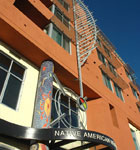They refer to themselves as “urban Indians,” 12,000 Native Americans from approximately 70 tribes who now call the East Bay—Oakland, California, and the surrounding area—home. Geographically dispersed, many now converge at the Seven Directions Native American Health Center for medical and dental care.
 The center is a joint venture between the Native American Health Center and the East Bay Asian Local Development Corporation. It sits on just two-thirds of an acre, which offered no small challenge to Pyatok Architects, an Oakland firm with an extensive body of work in multiunit housing. The 70,000-square-foot, five-story facility includes the clinic, a 45-car garage, 36 affordable apartment units, a community room, and laundry facilities. Remarkably, the limited footprint of the building still includes two courtyards, one of which holds a dirt-floor circle known as a kiva. A ceremonial place within Puebloan culture, a kiva is traditionally used for ritual dance and encircled by seating that (at the health center) otherwise allows contemplation and communal exchange.
The center is a joint venture between the Native American Health Center and the East Bay Asian Local Development Corporation. It sits on just two-thirds of an acre, which offered no small challenge to Pyatok Architects, an Oakland firm with an extensive body of work in multiunit housing. The 70,000-square-foot, five-story facility includes the clinic, a 45-car garage, 36 affordable apartment units, a community room, and laundry facilities. Remarkably, the limited footprint of the building still includes two courtyards, one of which holds a dirt-floor circle known as a kiva. A ceremonial place within Puebloan culture, a kiva is traditionally used for ritual dance and encircled by seating that (at the health center) otherwise allows contemplation and communal exchange.
The kiva is a common element in Native American culture and one of seven circular symbols referenced by the name Seven Directions. The seven directions—north, south, east, west, up, down, and the inner path—are further represented by three circular waiting and reception rooms, a medicine wheel etched and stained in the concrete floor, a round window, and a medicine wheel attached to a stylized steel eagle’s feather on the exterior. Additional symbolism is found in the building’s wooden totems and glyphs and on a mosaic-clad column.
The kiva is itself dirt on the ground level, and it’s surrounded by a rock-plant wall. “The kiva should be connected to nature and the Earth,” principal Michael Pyatok says. “It’s a gathering place where people from the community come together to discuss their problems and how they can solve them collectively. A strong community is the foundation for a healthy individual.”
The building reduces stress on the environment as well. It exceeded California’s Title 24 standards for sustainable construction by 20 percent with Energy Star appliances, low-E windows, and locally sourced building materials with recycled content. Stepped massing allowed the client to establish friendly relations with the neighbors by not blocking solar access. Nishkian Menninger Engineers served as the structural engineer, which it has done for several Pyatok projects, particularly those with a mix of wood and concrete. The architects themselves are experienced in contextually compatible architecture and have an extensive portfolio of award-winning urban-infill projects. They routinely engage communities in early-planning charettes to earn the support of the neighborhood.
The Orchards on Foothill, a 50,000-square-foot, 65-unit senior-housing project set on a half acre, also in Oakland, is another such project from Pyatok. The densely built facility employs heavy timber brackets to evoke a contemporary Arts and Crafts façade motif common to the neighborhood and familiar to its senior residents. About half the units enjoy east and west exposures while trellises and pilasters at the street-front arcade lead the eye to a distinct roofline cornice. “The crowning cornice ennobles the building and crowns the seniors in recognition of their life’s accomplishments,” Pyatok says.
In a similar vein of contextualism, Pyatok’s design for the Fox Court Apartments, in Oakland’s Art Deco Uptown neighborhood, provides a modern, green, and affordable interpretation of the new and historic structures that surround it. Eighty units of residences, within 134,000 square feet, accommodate families and individuals. Art Deco-style bands of tiles on the Fox Court exterior refer to ethnic themes that include flying salmon, fox, and elephants; Japanese gardens; woven baskets; and roses. It’s a lively, diverse aesthetic, consistent with how Pyatok Architects unfailingly honors urban cultures and the people it helps house.

